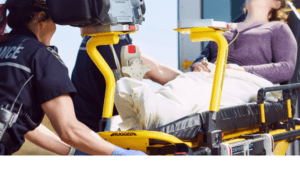It’s a great paradox that ambulances can represent such a dangerous environment. Their unsettling rate of crashes, per NHTSA’s Fatality Analysis Reporting System (FARS) data, is 3,200 per 100 million miles-eight times the rate of cars and light trucks. Other calculations range over 5,000. According to a study conducted last year, ambulance crashes are 27% more likely to be fatal than police equivalents, and 33% more likely than fire crashes. Overall, EMS workers’ on-the-job fatality rate is more than twice the national average, and nearly three-quarters of those deaths are transportation-related.
The threat is especially high when running hot, with 60% of crashes and 58% of fatalities happening with lights and sirens. Providers riding in the back are also at greatest risk. Over a 10-year period, 72% of those killed in ambulance crashes were in the back, although only 40% of total occupants were there. Many of these providers were working unrestrained, but even restrained providers can be at risk through design factors and structural vulnerabilities. Precise data can be hard to come by, but there’s no doubt the perils of transport are a major threat to the safety of providers, patients and the public at large.
But there’s good news too. In recent years the EMS profession has come a long way toward waking up to these dangers. And now, through the efforts of manufacturers, advocates and makers of advanced technologies like automated chest compression devices such as the ZOLL AutoPulse that benefit both patients and providers, we’re doing something about it.
“There are a number of areas where there’s been a lot of progress, but maybe the biggest is simply awareness,” says prominent ambulance safety expert Nadine Levick, MD, MPH, who heads the EMS Safety Foundation and Objective Safety, two organizations working to advance the cause.
“What we do is both medicine and transport. While we have fairly robust guidance on the medical side-with protocols, policies, research, evaluation and oversight-what’s happening now is a big movement forward on the transport side, with that same sort of focus, interest and scientific attention. That’s a huge step.”
In particular, the scientific aspect of current efforts is worth recognizing. The fact is that evidence-based, scientifically grounded interventions are preferable to those simply intuited, even by experts. For an example in the ambulance environment, look no further than side-facing bench seats and how providers are restrained in them. Absent crash data, you might think a body harness might keep a provider better restrained on such a seat than a mere lap belt. In truth, it transfers the entire force load in a frontal collision to the head/neck, rather than distributing it across the entire upper body, creating a large and dangerous injury risk. Such a restraint would, in reality, make a bad situation (side-facing seats) even worse.
What’s Helping
So what does the evidence say improves ambulance safety? Start with driver monitoring systems that provide real-time auditory feedback when certain operational parameters (speed, acceleration, turning forces, etc.) are exceeded.

“The feedback devices, because they serve as both a training tool and a systemwide data collection tool, are probably head and shoulders above everything else as far as bang for your buck,” says Levick. “They give you an outcome that’s measurable and that’s directly attributable to a safety solution.”
For the research supporting that, see objectivesafety.net. Meanwhile, new smartphone-based technologies now being trialed may soon present a cheaper, easier way to accomplish similar objectives.
Electronic stability control (ESC) systems also have solid backing data. ESC is a computerized technology to detect and mitigate skids. When an ESC system identifies a loss of steering control, it automatically applies the brakes, and may cut engine power, to help control and direct the vehicle. According to NHTSA and the Insurance Institute for Highway Safety, up to a third of fatal accidents might be prevented this way. ESC is increasingly featured in EMS apparatus, particularly modern van-type units, and could be especially beneficial in rural areas, where single-vehicle crashes produce so many ambulance-related injuries.
Data describing the risks of crashes to unrestrained providers is also helping create a trend toward smaller ambulances, such as the Mercedes Sprinter. This notion, flouting the idea that bigger is better, has been a hard sell at times. But a smaller environment, artfully arranged, means providers can reach what they need without getting unbuckled and moving around. They’re also more fuel efficient and cheaper to buy and use.
“Ten years ago, people didn’t want to look at a vehicle like a Sprinter,” says Levick. “Now people have been exposed to those vehicles and realize they can actually reach the patient and their equipment without having to walk around. Everything is a lot more ergonomically comfortable and, from a vehicle safety and handling point of view, more effective.”
That’s fine for new ambulances, but the larger, older models populating so many fleets aren’t leaving the road any time soon. For them it becomes about technologies and procedures that can mitigate known risks. And we know that riding unrestrained is among the greatest of those.
Technologies discussed throughout this supplement can help limit activities that can require unbuckling and standing and moving about. Smart protocols can too. Some agencies, for instance, are looking at terminating futile resuscitations in the field, rather than transporting patients who aren’t viable. Others are reevaluating how emergently they transport. Ft. Worth’s MedStar, for one, recently stopped using lights and sirens when CPR is ongoing for cardiac arrest patients it transports. “Traveling in the emergency mode makes it more difficult for crews to perform procedures such as CPR, IVs and EKGs,” a service official explained. “And our studies have shown that traveling with lights and siren only saves an average of two minutes in travel time to the hospital.”
Putting It Into Practice
As we zero in on what ambulance safety looks like, what we learn is making its way to the field. Manufacturers are striving to incorporate advances and build safer products, and prudent buyers are increasingly demanding features toward that end. Texas service CareFlite drew a lot of attention earlier this year with a high-profile commitment to the concept. President Jim Swartz worked with the EMS Safety Foundation to identify international best practices in ambulance safety. CareFlite then became the first ground service in the U.S. to completely eliminate side-facing seats in its emergency vehicles. It is rolling out 24 new ambulances-Sprinters from Crestline-with forward-facing seats, tested to 20 Gs, that swivel to the side and fold up when not in use. “The seated medic can reach all of his soft goods without ever having to unbuckle, so there’s very little that would require him to get out of that seat,” Swartz told EMS Magazine in March 2010.
The vehicles will also feature easily accessible monitoring and suctioning equipment on the forward wall facing the medics, and special exterior compartments for loose equipment that might otherwise become projectiles in a crash.
Word is spreading. The NFPA is now working on ambulance standards. Interest has soared in the international ideas showcased at conferences like Europe’s RETTmobil, and entire state EMS offices are striving to do better.
“There was enormous interest in the National Academies’ 2008 and 2009 (Transportation Research Board Ambulance Transport Safety) summits because people realize there are technical experts in fields like automotive safety and ergonomics who can work with the EMS community to bridge gaps and provide access to information,” says Levick. “For EMS, it feels like there’s a brand new world opening up where there are all these resources and people motivated to move the playing field forward. I think the cat’s out of the bag, and we’re all going to benefit.”
